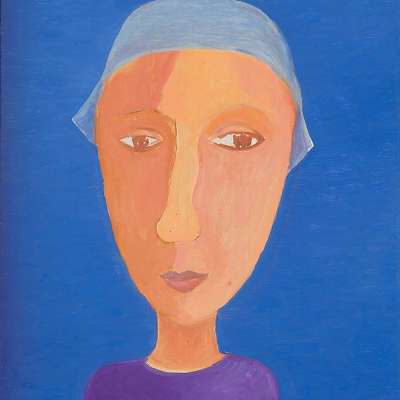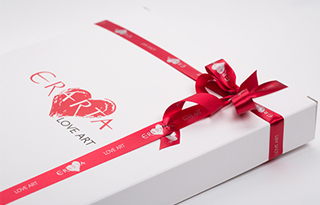Figurina Elena
Elena Figurina was born in Latvia in 1955, which at the time was part of the communist USSR. In 1969, consequently to her family moving to St. Petersburg, Figurina became increasingly involved and interested in the arts. Nonetheless, due to the absence of financial support for artists at the time, as well as the external pressure exerted upon her by her family, Figurina was accepted into the Leningrad Institute of Aviation. Figurina commenced her education within the institute with engineering, although she went on to graduate as a sculptor and modeler. Furthermore, throughout her studies and following her graduation, Figurina was also continuously participating and securing both solo and group exhibitions.
By the time of her graduation and due to the increased external interest towards her works, Figurina joined the Letopis' art group headed by Boris Koshelokhov. On account of the nature of the artworks that were actualized by the group, the Letopis were accused of not complying with the politically accepted artistic rules and regulations. At the time, social realism was the only satisfactory movement that was approved by the government, ensuring that one of the exhibitions, as set up by the Letopis group n 1978 was indeed shut down. 1981 saw Figurina join the Association of Experimental Art (TEII), which was created in order to organize non-conformist underground exhibitions.
The Contemporary Art Academy of the Deathless, another avant-garde contemporary Russian art circle, as led and founded by Felix Volosenkov counted Figurina as a member from 2000 onwards. The founder’s intention was to unite acknowledged and innovative artists in Russia at the time. This artistic affiliation with the group as well as her exponential rise to fame, has secured Figurina as the epitome of a St. Petersburg artist.
Figurina confesses that she can't live without her work. Perpetually, Figurina keeps asking herself if she is a true artist, as she treats art neither as a profession nor a vocation. Art is Figurina’s individual way of existing as a rational and sentient being. Figurina maintains that the production of art is not just a laborious process in terms of physicality of it, but should also be considered an emotional challenge as well. Finding the delicate balance of expressing your inner most being without falling over the edge into insanity, is the ultimate task when it comes to art, according to Figurina.
Overall, since her membership at the St. Petersburg Academy of Modern Art as one of the resident artists in 2000, Figurina has participated in over 200 exhibitions both in Russia and abroad. Figurina's paintings and sculptures are part of museum and private collections in Australia, Belgium, Denmark, England, France, Finland, Germany, Holland, South Korea, Norway, Poland, Russia, Sweden, Switzerland, and the United States.

Selected Solo Exhibitions:
-
2006 ITF Art, M'ars Gallery, Moscow, Russia.
-
2004 Gallery AnnaNova, St. Petersburg, Russia.
-
2004 Nabokov Museum, St. Petersburg, Russia.
-
2004 D-137 Gallery, St. Petersburg, Russia.
-
2001 Na Obvodnom Gallery, St. Petersburg, Russia.
-
2001 Agents Gallery, Hamburg, Germany.
-
2001 D-137 Gallery, St. Petersburg, Russia.
-
1998 Center of Modern Art, State University of St. Petersburg, Russia.
-
1997 Werdermann Art Gallery, Hamburg, Germany.
-
1996 Museum of Anna Akhmatova, Fountain House, St. Petersburg, Russia.
-
1995 State Museum of Theater and Music Arts, St. Petersburg, Russia.
-
1992 Werdermann Art Gallery, Hamburg, Germany.
-
1992 International Images Gallery, Sewickley, PA, USA.
-
1992 Gelman Gallery, Moscow, Russia.
-
1991 Lind and Andreasen Gallery, Aarhus, Denmark.
-
1990 Avrora Magazine Exhibition Hall, St. Petersburg, Russia.
-
1990 Gallery Exhibit, Berlin, Germany.
-
1989 Gallery Klein Typografie, Hamburg, Germany.
Selected Group Exhibitions:
-
2006 State Russian Museum, Time of Changes: Art of 1960-1985 in the Soviet Union, St. Petersburg, Russia.
-
2003 State Tretyakov Gallery, Avant-garde, Second Part of the XX Century, Moscow, Russia.
-
2002 Ludwig Museum, Der Russische Symbolismus, Koblenz, Germany.
-
2002 State Tretyakov Gallery, Femme Art, Women Painting in Russia, XV-XX Centuries, Moscow, Russia (catalogue).
-
2002 State Russian Museum, Twosome, St. Petersburg, Russia.
-
2001 Central Exhibition Hall of Union of Artists, Academy of Contemporary Art, About Love, St. Petersburg, Russia.
-
2001 Central Exhibition Hall, Manege, In Search of the Missing Link, St. Petersburg, Russia.
-
2001 Gallery D-137, St. Petersburg, Russia.
-
2001 Gisich Art Gallery, St. Petersburg, Russia.
-
2000 La Papessa Gallery, Vienna, Austria.
-
1976-90 Annual exhibitions of Leningrad unofficial artists, Russia.
Selected Public and Private Collections:
-
State Tretyakov Gallery, Moscow, Russia;
-
State Russian Museum, St. Petersburg, Russia;
-
State Hermitage Museum, St. Petersburg, Russia;
-
Museum of History of St. Petersburg, St. Petersburg, Russia;
-
Museum of Theater and Music Arts, St. Petersburg, Russia;
-
Norton & Nancy Dodge Collection of Soviet Nonconformist Art, Zimmerli Museum, New Brunswick, NJ, USA;
-
Museum of Fine Arts, Sevastopol, Russia;
-
Oregon University Museum of Art, Eugene, USA;
-
Museum of Modern Art, St. Petersburg, Russia;
-
Museum of Nonconformist Art, St. Petersburg, Russia;
-
State Museum of Astrakhan, Russia;
-
State Museum of Khabarovsk, Russia;
-
State Museum of Kazan, Russia;
-
State Museum of Kaliningrad, Russia.





